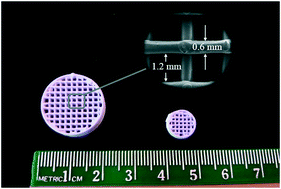当前位置:
X-MOL 学术
›
React. Chem. Eng.
›
论文详情
Our official English website, www.x-mol.net, welcomes your
feedback! (Note: you will need to create a separate account there.)
3D-printed zeolite monoliths with hierarchical porosity for selective methanol to light olefin reaction
Reaction Chemistry & Engineering ( IF 3.4 ) Pub Date : 2018-07-18 00:00:00 , DOI: 10.1039/c8re00095f Xin Li 1, 2, 3, 4 , Fateme Rezaei 1, 2, 3, 4 , Ali A. Rownaghi 1, 2, 3, 4
Reaction Chemistry & Engineering ( IF 3.4 ) Pub Date : 2018-07-18 00:00:00 , DOI: 10.1039/c8re00095f Xin Li 1, 2, 3, 4 , Fateme Rezaei 1, 2, 3, 4 , Ali A. Rownaghi 1, 2, 3, 4
Affiliation

|
Herein, we report the rapid synthesis of customized zeolite monoliths with various compositions and hierarchical porosity (macro–meso–micro) using a 3D printing technique. Moreover, several 3D-printed monoliths were synthesized from HZSM-5 and HZSM-5/silica, and SAPO-34 crystals were grown on the as-synthesized 3D-printed ZSM-5 monoliths via a secondary growth method. The 3D-printed zeolite monoliths exhibited hierarchical porosity with pore sizes ranging from 1.5 nm to 1 μm. Characterization results suggested that transformation of zeolite paste into the monolith structure enhanced the mesopore volume and moderated the acidity of the structures. Further incorporation of amorphous silica into the HZSM-5 monoliths reduced the acid site density. The obtained monoliths were evaluated in the methanol to olefin (MTO) reaction and found to exhibit higher stability than their powder counterparts. The selectivity to light olefins was significantly increased as a result of modification in the acidity and porosity of the monolith catalysts, which in turn mitigated the hydrogen transfer, hence suppressing the formation of paraffins and aromatics. The SAPO-34 coating tended to increase the ethylene selectivity due to its intrinsic framework structure. The analysis of spent zeolite monoliths by TGA-DTA indicated that the amount of polyaromatic species formed during the reaction was much lower than that on the powder analogues, due to their diluted acid site density and decreased Brønsted acid sites, as proven by NH3-TPD profiles and py-FTIR spectra. Furthermore, 29Si MAS NMR results confirmed slight dealumination of 3D-printed monoliths after the MTO reaction.
中文翻译:

具有分级孔隙率的3D打印沸石整料,用于选择性甲醇与轻质烯烃反应
在本文中,我们报道了使用3D打印技术快速合成具有各种组成和分级孔隙率(宏观-中观-微观)的定制沸石整料的过程。此外,从HZSM-5和HZSM-5 /二氧化硅合成了3D打印的整体结构,并通过合成的3D打印的ZSM-5整体结构,通过以下步骤生长了SAPO-34晶体:次生生长方法。3D打印的沸石整料显示出分级的孔隙率,孔径范围为1.5 nm至1μm。表征结果表明,沸石糊转变成整体结构增加了中孔体积并缓和了结构的酸度。将无定形二氧化硅进一步掺入HZSM-5整体中会降低酸位密度。在甲醇制烯烃(MTO)反应中评估了获得的整体料,发现其整体稳定性高于其粉末对应物。通过改变整体催化剂的酸度和孔隙率,对轻质烯烃的选择性显着提高,从而降低了氢的转移,从而抑制了链烷烃和芳烃的形成。SAPO-34涂层由于其固有的骨架结构而倾向于提高乙烯的选择性。TGA-DTA对废沸石整料的分析表明,在反应过程中形成的多芳族物质的数量比粉末类似物要低得多,这是因为它们的稀释酸位点密度和布朗斯台德酸位点减少,这已被NH证明。3 -TPD谱图和py-FTIR光谱。此外, 29 Si MAS NMR结果证实了MTO反应后3D打印的整料略微脱铝。
更新日期:2018-07-18
中文翻译:

具有分级孔隙率的3D打印沸石整料,用于选择性甲醇与轻质烯烃反应
在本文中,我们报道了使用3D打印技术快速合成具有各种组成和分级孔隙率(宏观-中观-微观)的定制沸石整料的过程。此外,从HZSM-5和HZSM-5 /二氧化硅合成了3D打印的整体结构,并通过合成的3D打印的ZSM-5整体结构,通过以下步骤生长了SAPO-34晶体:次生生长方法。3D打印的沸石整料显示出分级的孔隙率,孔径范围为1.5 nm至1μm。表征结果表明,沸石糊转变成整体结构增加了中孔体积并缓和了结构的酸度。将无定形二氧化硅进一步掺入HZSM-5整体中会降低酸位密度。在甲醇制烯烃(MTO)反应中评估了获得的整体料,发现其整体稳定性高于其粉末对应物。通过改变整体催化剂的酸度和孔隙率,对轻质烯烃的选择性显着提高,从而降低了氢的转移,从而抑制了链烷烃和芳烃的形成。SAPO-34涂层由于其固有的骨架结构而倾向于提高乙烯的选择性。TGA-DTA对废沸石整料的分析表明,在反应过程中形成的多芳族物质的数量比粉末类似物要低得多,这是因为它们的稀释酸位点密度和布朗斯台德酸位点减少,这已被NH证明。3 -TPD谱图和py-FTIR光谱。此外, 29 Si MAS NMR结果证实了MTO反应后3D打印的整料略微脱铝。










































 京公网安备 11010802027423号
京公网安备 11010802027423号